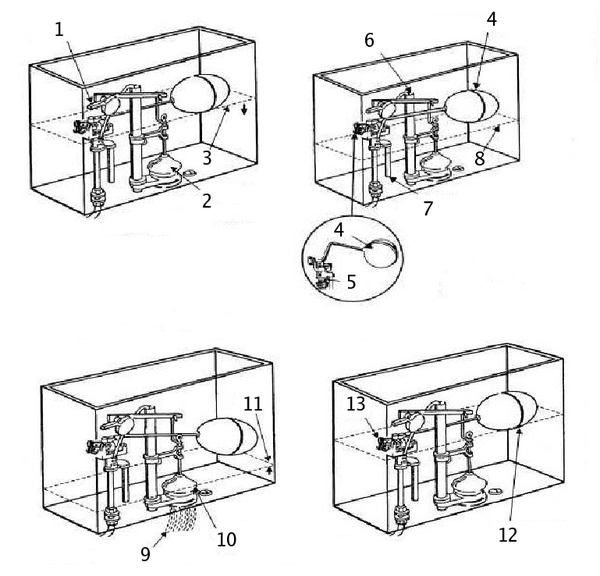Difference between revisions of "AY Honors/Plumbing/Answer Key"
| Line 36: | Line 36: | ||
12: Float ball rises<br> | 12: Float ball rises<br> | ||
13: Valve closes]] | 13: Valve closes]] | ||
| + | <br style:"clear:all"> | ||
To repair a toilet flush mechanism, remove the tank lid, flush the toilet and observe. See which of the thirteen steps listed above is not happening, try to determine why it is not happening, and address the problem. In some cases it is easier to replace the flush mechanism rather than repair an existing one. The replacement parts are sold in a single package and comes with instructions geared toward a typical homeowner. Since Pathfinders tackling the Plumbing honor are not "typical," this shoud present no problems! | To repair a toilet flush mechanism, remove the tank lid, flush the toilet and observe. See which of the thirteen steps listed above is not happening, try to determine why it is not happening, and address the problem. In some cases it is easier to replace the flush mechanism rather than repair an existing one. The replacement parts are sold in a single package and comes with instructions geared toward a typical homeowner. Since Pathfinders tackling the Plumbing honor are not "typical," this shoud present no problems! | ||
Revision as of 02:35, 4 October 2006
1. Make a diagram showing the plumbing system of a four-room house which includes fixtures for the kitchen, bathroom, and laundry.
 This diagram shows the pipes and fixtures involved in plumbing a typical four-room house.
This diagram shows the pipes and fixtures involved in plumbing a typical four-room house.
2. Submit two pieces of iron pipe that you have threaded and connected with proper fitting.

Insert the correct size die into the die stock. Slide the die stock over the pipe and apply pressure with one hand. With the other hand, turn the stock handle slowly clockwise until the die has taken a bite on the pipe. Apply cutting oil to the die as the stock handle is given one complete clockwise turn and backed off a quarter turn. Repeat this action until 1/4 inch of the pipe is beyond the die stock. The pipe is now threaded properly. Turn the handle in a counterclockwise direction to remove the pipe.
3. Submit a repaired plastic (PVC), iron, or copper pipe, and tell how to repair all three.
PVC
Turn off the water, then cut out the damaged section of pipe using a hacksaw or a handsaw. Then clean the two ends of the existing pipe thoroughly and let it dry. Cut a new piece of PVC pipe the same length as the damaged and removed piece and make sure it is clean too. Apply PVC primer and cement to the ends of the replacement pipe and slide couplings over them, one on each side. Then apply PVC primer and cement to the existing pipes, and join them together. Let the cement cure for the amount of time indicated on the can. Finally, turn the water back on and check for leaks.
Iron
In galvanized pipe installations, where the fittings on either side of the leak are not readily available, the leaking section may be cut out. In this operation, one person holds the pipe with a wrench to keep it from turning in the next fitting, and another person cuts a thread on it while it is in place using a hand type of pipe threader. The cutout section is then replaced with a coupling, a pipe section of the required length, and a union.
Copper
If a copper pipe leaks, cut out the damaged section and replace it with a new section, using either soldered or compression-type joints. Soldering requires quite a bit of skill, and there is always the risk of setting a house on fire with a soldering torch. Watch where the flame goes at all times. It is easy to get absorbed in watching the solder joint and not notice that the flame is licking a joist behind the pipe. Pay attention!
4. Demonstrate ability to repair a leaky sink faucet and replace or repair toilet flush mechanisms.
Leaky Faucet
Toilet Flush Mechanism
Before a person can repair anything, he or she must understand how that item is supposed to work. The illustration below shows the steps in a toilet flush mechanism:

2: Stopper ball is lifted, opening tank drain
3: Water level in tank begins to drop
4: Float ball lowers
5: Valve opens allowing fresh water in
6: Water is sprayed into bowl from the top
7: Water enters tank
8: Water level continues to drop
9: Water exits tank and fills bowl
10: Stopper ball reseats
11: Water level rises
12: Float ball rises
13: Valve closes
To repair a toilet flush mechanism, remove the tank lid, flush the toilet and observe. See which of the thirteen steps listed above is not happening, try to determine why it is not happening, and address the problem. In some cases it is easier to replace the flush mechanism rather than repair an existing one. The replacement parts are sold in a single package and comes with instructions geared toward a typical homeowner. Since Pathfinders tackling the Plumbing honor are not "typical," this shoud present no problems!
